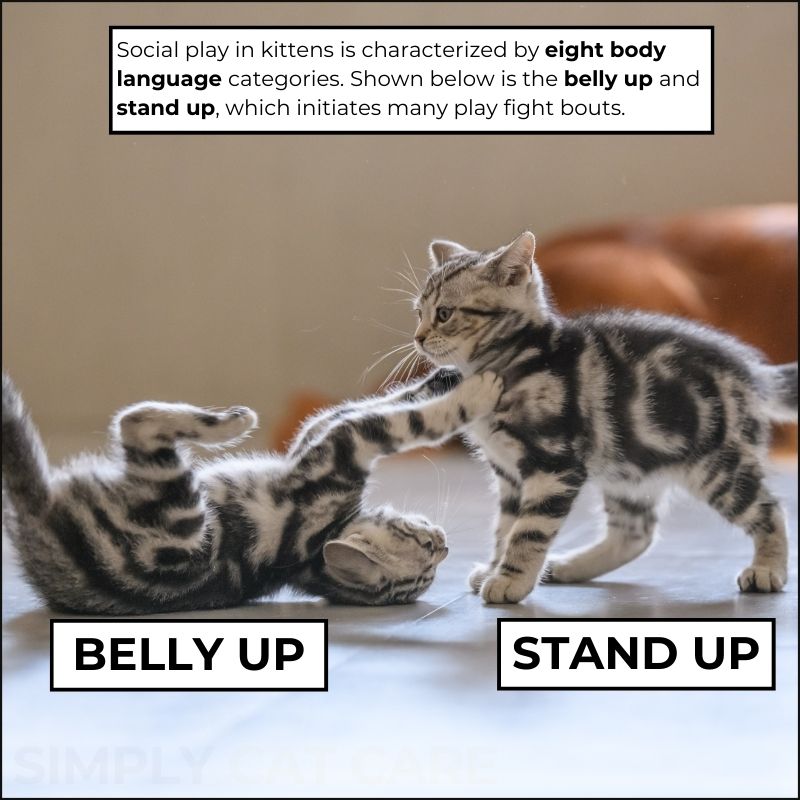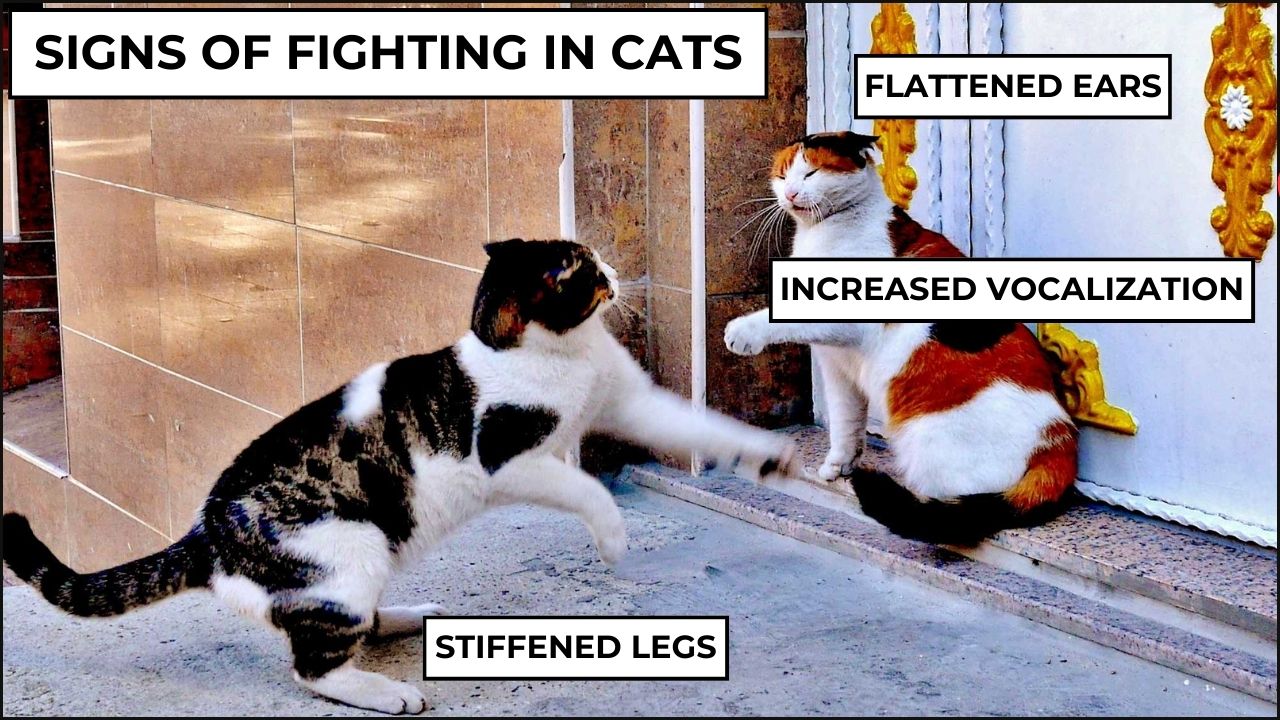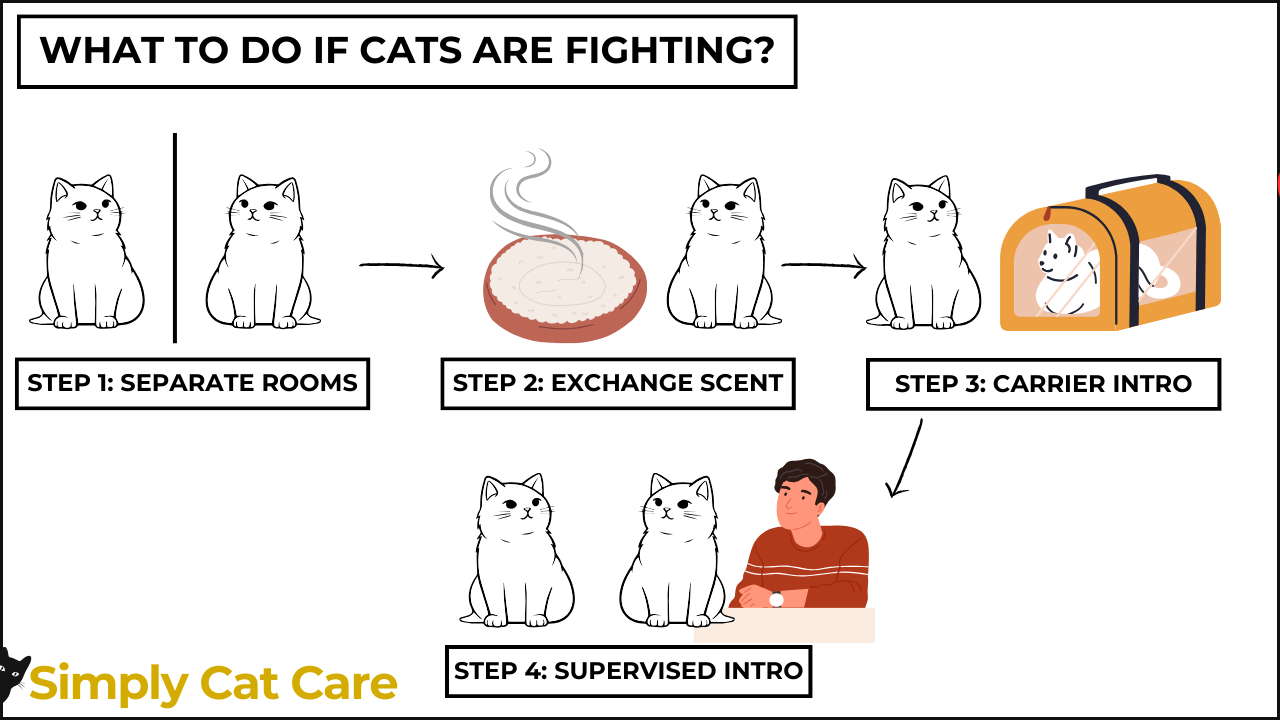Why do cats play fight?
Social play between littermates and kittens is helpful to:
- Improve social bonds
- Increase physical conditioning
- Develop skills for hunting
- Improve social development
- Learn how to play with our cats
Gaining physical skills is important for cats as carnivores. They evolved to hunt, stalk, and kill prey.
This form of social play decreases in kittens after 18 weeks.
Play fighting behavior includes common signs to help you recognize if your cats are playing.
However, sometimes tensions spill over and it’s hard to know if your cats are fighting.
Aggression between cats is a problem as it can cause stress, which leads to problems like house soiling and cystitis. The fighting can also cause injury to you or your cat.
Either way, you’ll want to know how to tell if your cats are playing or fighting and decide whether it’s time to intervene.
I’ll help you do that with this article, as I go in depth into what all this playing means, how to know if your cats are likely fighting, and what to do about it.
Why Do Cats Play Fight?
Cats are carnivores and play fighting helps hone their hunting skills.
This type of play is called social play is occurs most between the ages of 4-16 weeks. A kitten will play with their littermates or mother, depending on who’s around.
As mentioned in the intro, this type of play can help cats develop their skills for hunting. Cats have only enjoyed about 10,000 years of human domestication and have retained much of their wild behavior.
For all they know, they’re preparing for a life of needing to hunt and kill to survive. At 9 weeks, kittens will get in around 46 minutes of social playtime every day.
Body Language Signs of Cats Playing
Researchers in the 1970’s took 28 kittens from four mothers, housing them in a laboratory for two years.
They observed the following eight patterns that are signs of playful interactions between two cats:
- Belly up: Kittens mouth is open and they are treading with their legs in the air, waiting for play initiation.
- Stand up: Mouth open and standing over a kitten using the ‘belly up’ position. Will bite into other kitten to start play.
- Face off: A kitten will hunch towards another and direct paw movements to the other.
- Vertical stance: A kitten sitting and rocking on their hind legs. Paws stretched perpendicular to their body.
- Horizontal leap: Standing lateral to the other kitten with it’s tail upward, a kitten leaps on the other.
- Side step: Tail curled up with an arched back. Kitten walks sideways.
- Pounce: Crouches low with hind wriggling in the air, and leaps.
- Chase: Running around the house after each other.
Any of these signs between cats generally means play. Kittens usually take turns in these skirmishes.
However, kittens redirect their attention to other things as they reach adulthood.
Unneutered males will start to direct attention towards mating behavior around 4.5 months (females at 5.5 months).
Adult cats will tend to want to enjoy interactive toys and other forms of object play.

The Purpose of Play Fighting in Cats
Social play fighting helps:
- Improve social bonds
- Increase physical conditioning
- Develop skills for hunting
- Improve social development
- Learn how to play with our cats
Remember that kittens are generally into social play, which makes sense to give them a chance to prepare skills for hunting.
Difference Between Playing and Fighting in Cats
A recent paper showed that not all play fighting is mutual.
Signs your cats are actually fighting include:
- Arched back
- Avoidance
- One cat retreating during play
- Piloerection (tail high in the air)
- Increased vocalization
- Increased chasing
Behavior occurs on a spectrum, meaning a small amount of vocalization (loud noises) and chasing is expected. Too much is a sign of fighting between cats.
Like humans, sometimes cats just don’t get along. It happens.
Agonistic (non-friendly) relationships between cats have other clues including a lack of allogrooming, greeting (with ears erect), and tend to sleep apart.
In other words, cats that don’t like each other, won’t get along at any time of the day after a bit of a tussle.
An obvious sign for cat owners to look for is the presence of injury. Blood, tufts of fur, scratches and cuts are signs tensions have spilled over.
However, it may still be hard to identify the signs of aggression.
Why Are My Cats Are Fighting?
Aggression in cats is often due to having to share territorial space with new cats.
Unneutered males roam more territory and tend to start fighting other cats that get in their way. If your cat isn’t neutered, they might be more hostile.
A 2005 study surveyed over 200 cat owners. 50% had multi-cat households, and 50% of those reported aggression when a new cat was introduced.
As it turns out, wild cats form closely associated social groups with overlapping territory.
New cats aren’t well tolerated in these cat social circles.
A free roaming cats territory can span up to 620 hectares which is a far cry from the size of a standard family home (7.8 – 33 hectares).
It’s easy to see that this a cats innate desire to control territory comes under serious threat when a new cat comes into a relatively sparse area.
Males are the most common aggressor, with a male to male fight being most common. The least common situation is a female cat acting aggressive to a male, but it can still happen.
Free-ranging male cats have a strong evolutionary desire to control territory and their most precious resource – a female cat. This might explain why they’re more hardwired for fighting.
Some aggression is causes by undiagnosed medical conditions that can make cats feel threatened and start lashing out. This includes osteoarthritis, anal impaction and hyperthyroidism.
Cats living together can also fight over resources like food, litter boxes, cat trees and beds getting into conflicts over these items.
How Cats Act When Not Playing?
Aggression is characterized as offensive and defensive behavior.
Signs include:
- Flattened ears
- Tucked head
- Long meows and growls
- Stiffened legs

When to Intervene Cats Fighting or Playing?
If you notice any injury, it’s important to take steps to understand and manage conflicts between cats.
Cats can experience stress, even without injury.
Problems related to cat conflicts include inappropriate soiling, worsened quality of life, and redirected aggression towards an owner.
The problem could also be a sign of illness.
So waiting for things to escalate to bloodshed isn’t always the best idea. Instead, recognize the signs of fighting (e.g. ears back, excessive vocalization, avoidance, arched back) and be proactive.
A veterinarian assessment is a good first pet care step to find out if one or both cats has underlying medical issues.
As discussed earlier, adding a new cat to the home can lead to fighting. Unfortunately, waiting for things to settle down over time doesn’t always work and problems can continue indefinitely.
So you should do something about it – the question is what can you do?
What to Do If Cats Are Fighting?
Here are strategies to help avoid physical conflict between cats:
- Separation: Keeping cats in separate rooms will help avoid escalation. Let one cat sleep in your room away from the other. For serious cases, the separation may have to continue for days or weeks before attempting reintroduction.
- Treatment: A veterinary professional can help you diagnose underlying medical reasons for aggression.
- Toys: Allow the cats to interact in an enriching room with toys. Reinforce playing with toys with treats and use interactive toys (e.g. feather wands) with the aggressive cat to divert their attention away from the other cat.
- Neutering: Most cat behaviorists will agree that cats should be neutered. As mentioned earlier, male cats are more likely to start fights. Neutering is recommended not just for fighting, but to prevent unwanted pregnancies in cats.
- Decentralizing resources: Provide resources (e.g. litter trays, water bowls) in separate areas so cats can have their own equipment.
A 1997 study attempted six types of treatments for cat fighting including separation (with or without reinforcement), medical therapy, odor exchange and the use of cat carriers.
They all helped reduce catfighting, but none of the treatments was statistically better than the other. Meaning, there’s no ‘one proven fix’ to rule them all.
If all else fails, try to reintroduce cats by following these steps:
- Separate: Separate the cats into two rooms (make sure each cat has access to water, food, litter, toys in their room)
- Exchange scents: Take bedding from each cat and place in the others space (make sure they still have some of their own)
- Carrier: Use a carrier to introduce cats (see each other without physically being able to contact each other)
- Supervised access: Let the cats interact, but supervise and intervene if the cats don’t get along

Should You Discipline a Cat?
No.
Punishment is not a good way to improve cat behavior. This will increase stress, which has it’s own set of problems (e.g. increased aggression, soiling on the floor).
Instead think about the environment your cats live in. Is it cat friendly and enriching?
The best way to reduce stress and cats is to allow plenty of areas to perch, play, scratch and carry out normal behavior.
Conclusion
Most cats play fight when they’re kittens.
This helps prepare them for the wild, honing their hunting craft and learning how to socialize with other kittens. The playing is normal and healthy.
To tell if cats are playing or feuding, watch for body language.
Increased meowing and growling, injury, stiffened posture and stress related symptoms (e.g. peeing out of the litter box) are signs the cats are aren’t getting along.
Introducing another cat into the home can increase catfighting due to territorial behavior, especially in males.
If this happens, it’s best to try separate and carefully reintroduce cats in a controlled way.
Further reading:
